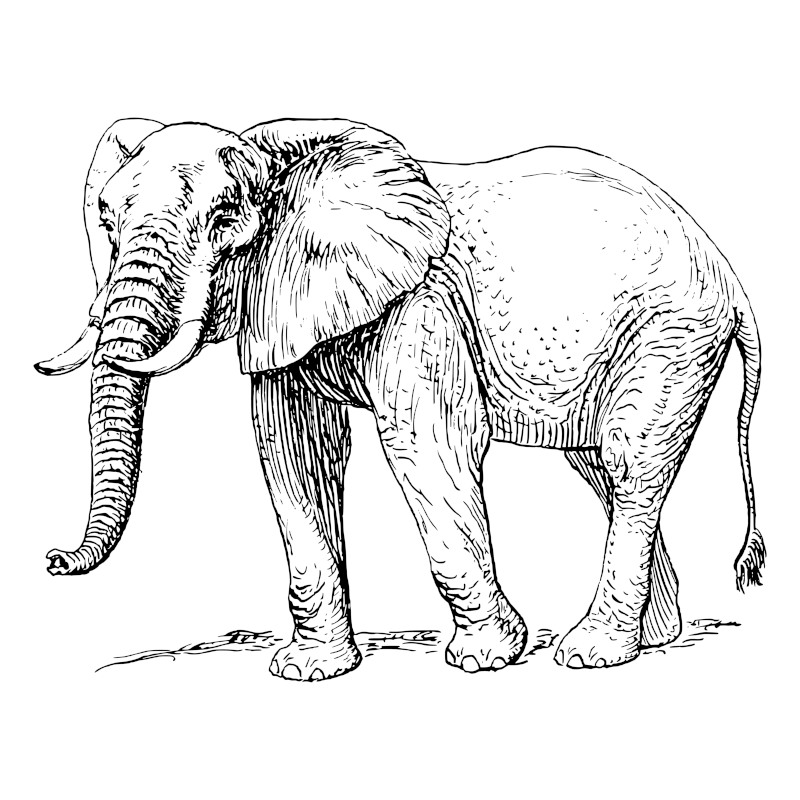Elephants have excited us all for centuries, with their unusual anatomies and behavior out in the wild. Artists have depicted these huge animals within their work, and slowly improved the accuracy of their paintings and drawings as our knowledge of these creatures evolved over time.
Introduction to Elephant Drawings
Elephants have excited many of us due to our inability to see them in the wild, other than for those able to travel to see them. Zoos have helped to change this somewhat, but even then, it is understood as being a contrived environment, and not quite the true experience. Elephants have also become under attack from poachers, which has sadly led to their numbers falling considerably, raising the profile of this animal in our thoughts.
Elephant art can help to spread the word about these injustices, as well as teaching us more about the animal itself. Conservation continues to be a growing interest and poster art can help to promote certain causes through its impactful messaging. We have therefore decided to provide a collection of elephant art for those looking to draw elephants themselves, and perhaps require some inspiration in order to make a start.
List of Elephant Drawings and Paintings
Please find below a list of elephant drawings and paintings, some of which were produced by famous artists, whilst others remain anonymous, to the best of our knowledge. All were sourced from Rawpixel, who provide them as copyright-free, and they can help you to learn more about how to draw an elephant, in a wide variety of ways. There are line drawings, paintings and other techniques included in this list.
Beneath the images are descriptions of each artwork, as well as information on each artist, when it is known. Below that you will find considerable discussion around a number of themes and topics related to elephant art, such as its use in modern conservation techniques, as well as a summary of how elephant drawings have changed over the years, as our knowledge of the animal has evolved over time. There has also been considerable variety in artistic styles from one culture or civilization to the next.
Simple, Quick Elephant Drawing
This illustration features an elephant in side profile, making its way across to our left hand side. The artist incorporates a high level of detail within this drawing, but for those looking to produce a quick, easy sketch, you can simple trace the outlines of this vintage artwork. Those more accomplished in drawing, could go in deeper, and continue to evolve their own work. There is considerable detail around the elephant's trunk, as well as on the contours of its ears and tail and torso. This sketch is devoid of color, allowing us to focus entirely on the anatomy of this wild animal.
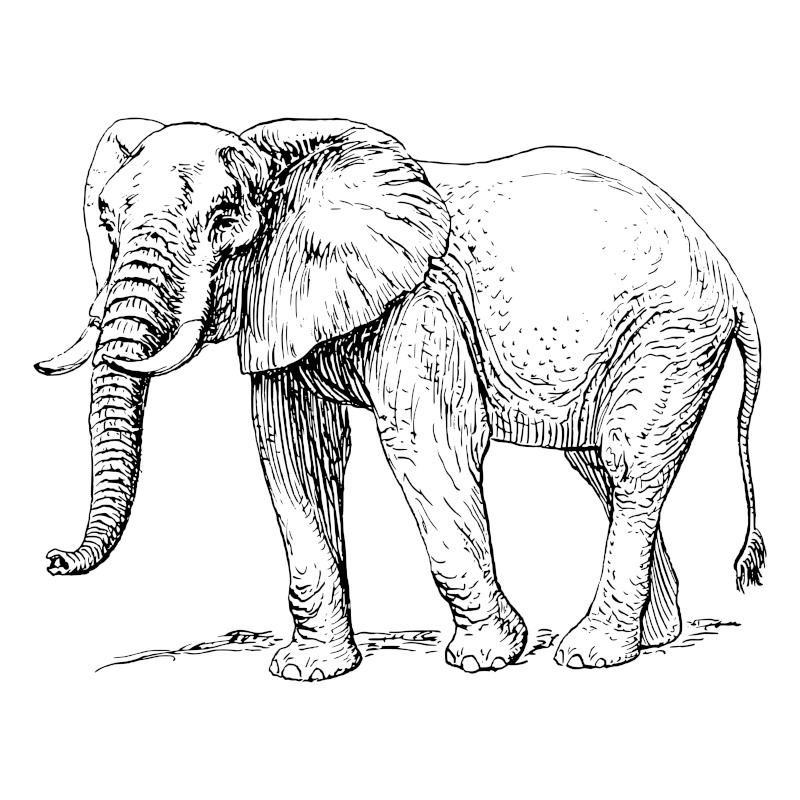 Simple, Quick Elephant Drawing (image courtesy of rawpixel)
Simple, Quick Elephant Drawing (image courtesy of rawpixel)
Walking Elephant Illustration in Black and White
In a similar manner to the previous work, there is considerable detail in this black and white sketch of this elephant. This time there is a small amount of habitat detail, allowing us to place this elephant within the wild in our minds. The level of precision means individual drawing marks are not visible, and we sit back to see this creation as a whole, rather than trying to deconstruct every action by the artist. The artist also incorporates elements of movement here, as suggested by its posture, and they may well have studied the creature in full flow in order to do this accurately.
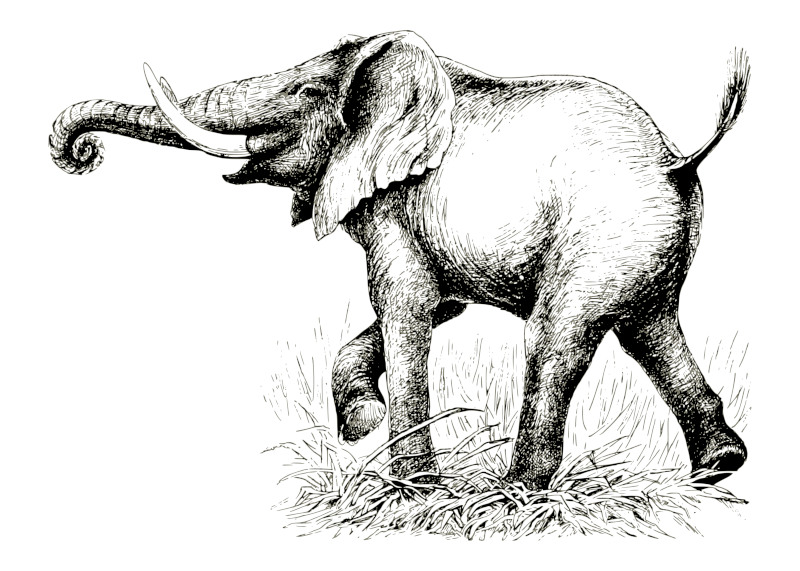 Walking Elephant Illustration in Black and White (image courtesy of rawpixel)
Walking Elephant Illustration in Black and White (image courtesy of rawpixel)
Elephant Drawing by Leo Gestel
Leo Gestel was a prolific European artist who produced abstract interpretations of animals, flowers and a number of other everyday subjects. He tended to focus on charm and simplicity within his line drawings, rather than desiring accuracy which had already been accomplished across the 18th and 19th century. His work proved popular within the mainstream, where his audience desired something fun and modern, having already enjoyed more scientific studies in previous decades. This Gestel sketch features an elephant, seemingly in a reflective mood.
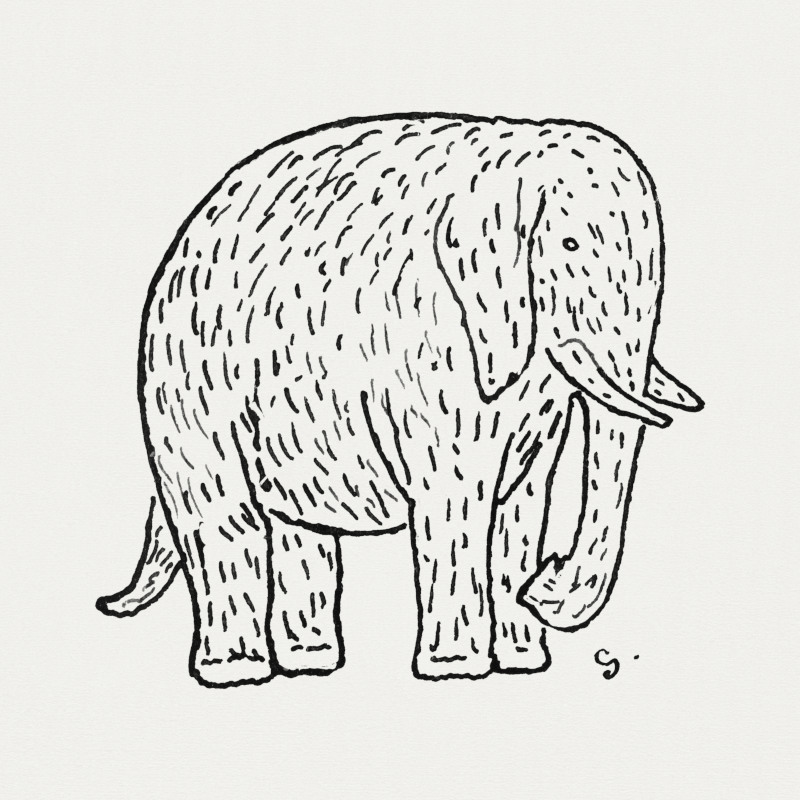 Elephant Drawing by Leo Gestel (image courtesy of rawpixel)
Elephant Drawing by Leo Gestel (image courtesy of rawpixel)
Two Studies of an Indian Elephant Head (1840) Animal Illustration by Thomas Daniell
Here we find an example of 19th century elephant drawings, where the artist attempts to produce accurate interpretations of an Indian Elephant's head. The work is lightly done, perhaps using watercolors in combination with drawing tools. There is some evidence of handwriting on the back of the paper, suggesting that the artist may have simply taken some scrap paper to work quickly from, and that this artwork was never intended to be seen publically, or sold commercially. Instead, it was for the purpose of study and practice.
 Animal Illustration by Thomas Daniell.jpg) Two Studies of an Indian Elephant Head (1840) Animal Illustration by Thomas Daniell (image courtesy of rawpixel)
Two Studies of an Indian Elephant Head (1840) Animal Illustration by Thomas Daniell (image courtesy of rawpixel)
Vintage Animal Illustrations (Head Profiles)
These delightful head studies are completed to a very high level and cover a variety of wild animals. The artist carefully arranges the different items to allow room for the elephant's trunk to hang down freely. Many of the other wild animals will be instantly recognisable to you, such is the quality of these paintings. There is a near photo-realistic quality to each, which could only be achieved through regular practice and lengthy spells of observation for each animal individually.
.jpg) Vintage Animal Illustrations (Head Profiles) (image courtesy of rawpixel)
Vintage Animal Illustrations (Head Profiles) (image courtesy of rawpixel)
Black Elephant with Pattern in Silhouette Drawing
This interesting artwork creates a silhouette of an elephant and fills much of it with a contrasting pattern which appears to have been inspired by Indian art. This combines, essentially, two artworks into one, and delivers an exciting contemporary artwork which could easily be re-used in alternative ways, such as a printed t-shirt, poster, or mug motif. There is also a charming blend of traditional with modern art, re-purposing vintage ideas in new ways.
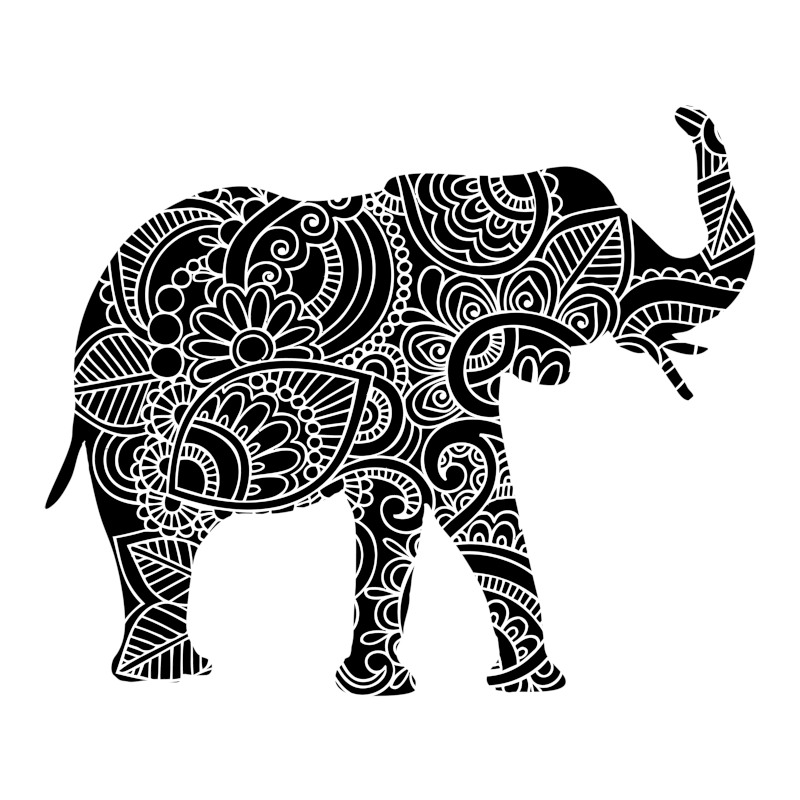 Black Elephant with Pattern in Silhouette Drawing (image courtesy of rawpixel)
Black Elephant with Pattern in Silhouette Drawing (image courtesy of rawpixel)
Vegetaline (1910) Vintage Elephant Poster by Leonetto Cappiello
Leonetto Cappiello produced some stunning poster art at around the turn of the century, and in this example he delivers a charming, upbeat image of a red elephant, who is ridden by what appears to be a chef or kitchen worker. It is to promote a particular product, but whilst this design is an advertising poster, it can be treated as a genuine artwork in its own right. Cappiello worked in this manner for much of his career, and this style of vintage poster which loosely connects with Art Nouveau art remains highly popular today.
 Vintage Elephant Poster by Leonetto Cappiello.jpg) Vegetaline (1910) Vintage Elephant Poster by Leonetto Cappiello (image courtesy of rawpixel)
Vegetaline (1910) Vintage Elephant Poster by Leonetto Cappiello (image courtesy of rawpixel)
Japanese Art Elephant From India With Tiger
We can learn much from this Japanese example of elephant art, with a woodblock print design that features a battle between this large creature and a smaller tiger. Whilst we can immediately identify the elephant, there are clearly some differences between its appearance and what we are used to seeing in person, when visiting their natural habitats, or even a local zoo. Clearly, at this time in Japanese history, elephants may not have been a common sight in Japan, but the artist is also likely to be expressing a certain level of creative freedom.
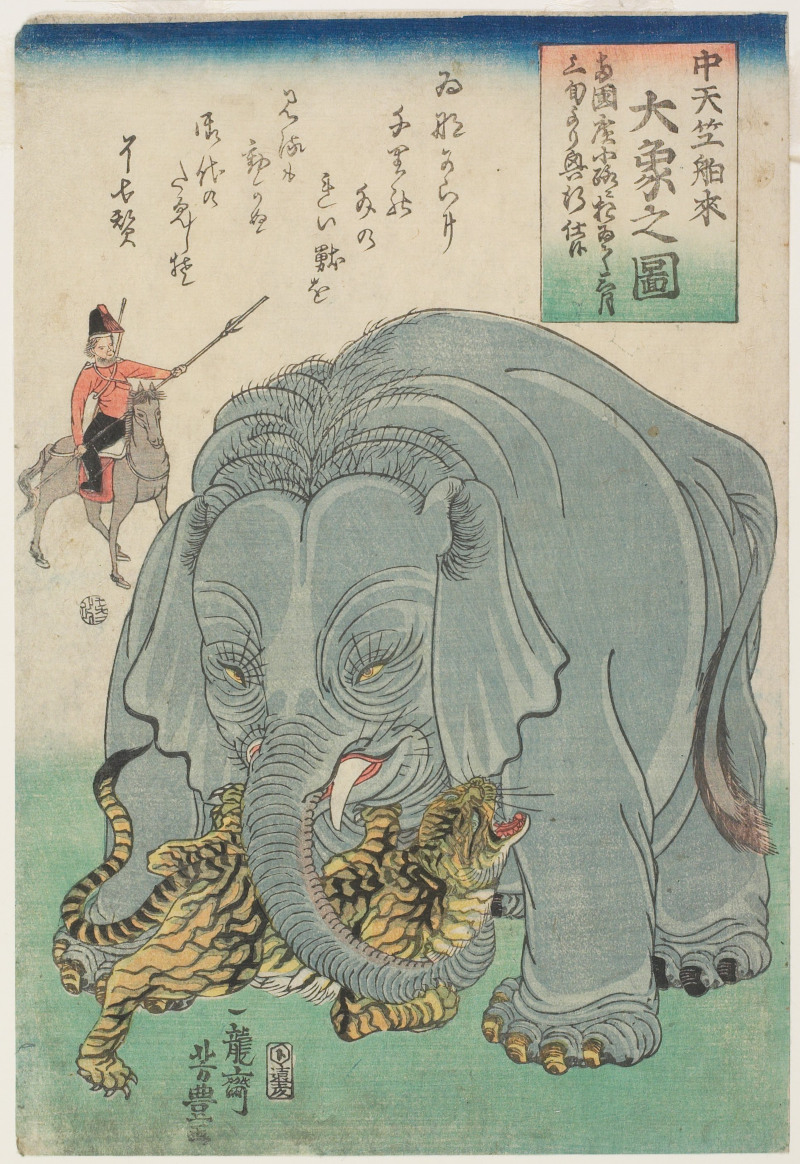 Japanese Art Elephant From India With Tiger (image courtesy of rawpixel)
Japanese Art Elephant From India With Tiger (image courtesy of rawpixel)
Ganesha Drawing, near Sita's Temple, Rangpur
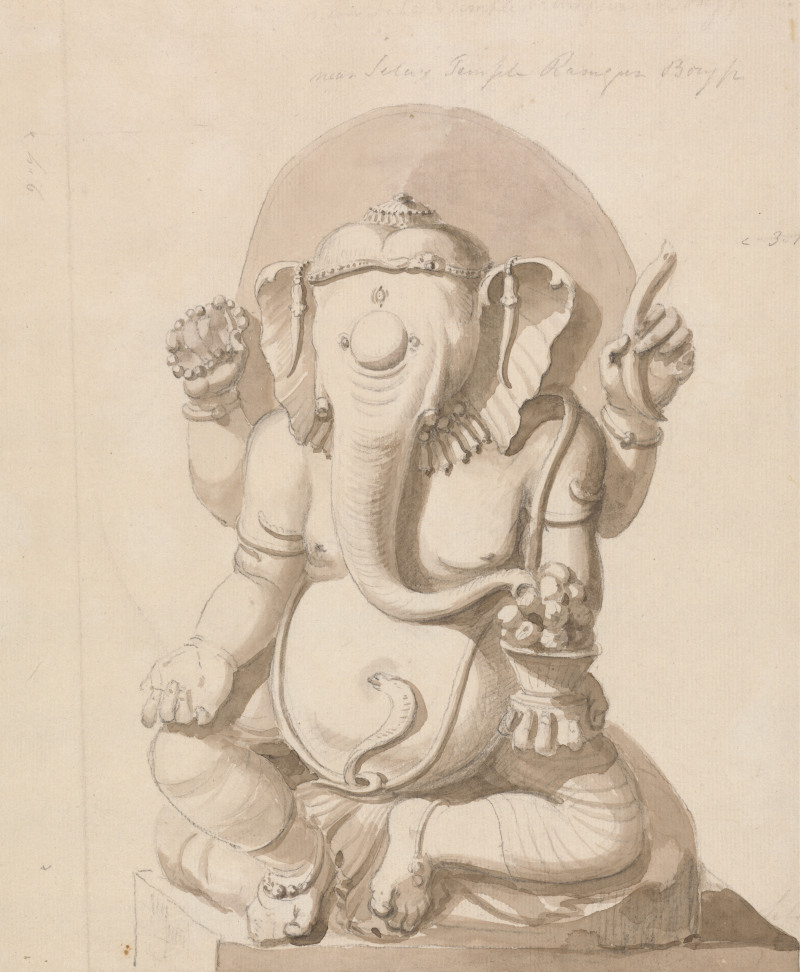 Ganesha Drawing, near Sita's Temple, Rangpur (image courtesy of rawpixel)
Ganesha Drawing, near Sita's Temple, Rangpur (image courtesy of rawpixel)
The Month of Jyaishtha
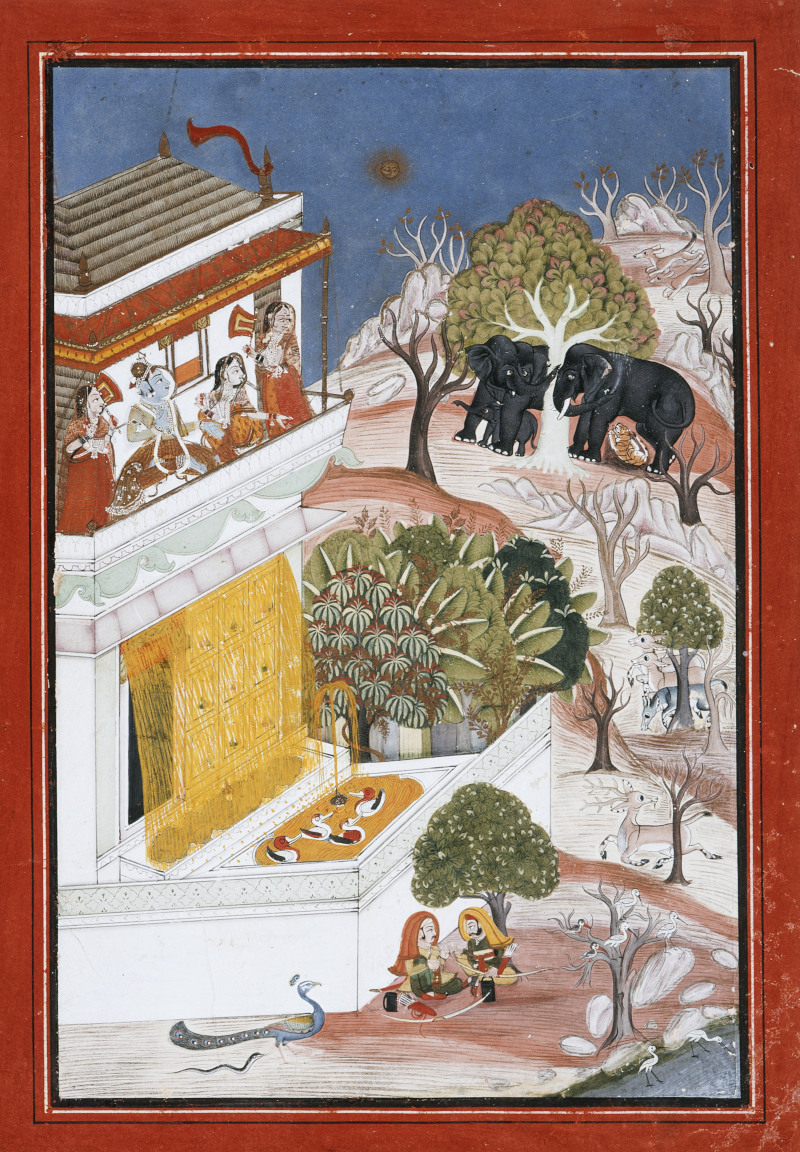 The Month of Jyaishtha (image courtesy of rawpixel)
The Month of Jyaishtha (image courtesy of rawpixel)
The Cremation of Peshwa Madhavrao I and the Sati of his Wife Ramabai
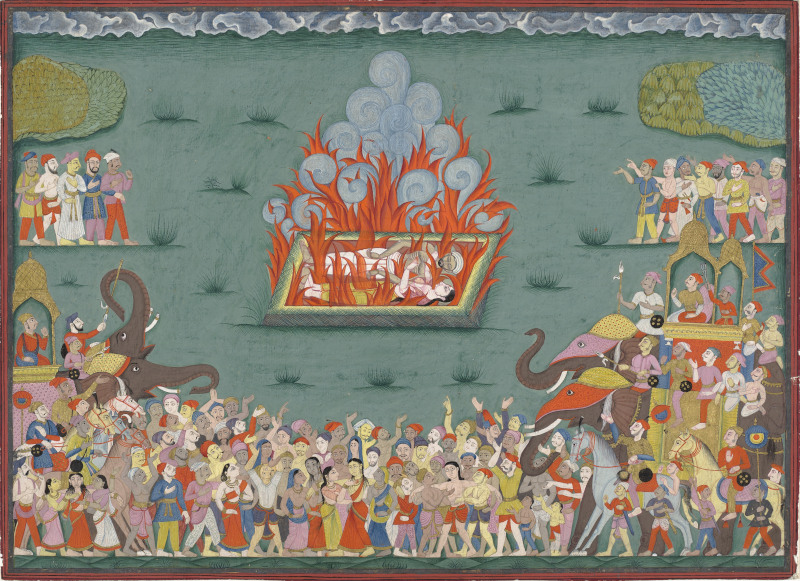 The Cremation of Peshwa Madhavrao I and the Sati of his Wife Ramabai (image courtesy of rawpixel)
The Cremation of Peshwa Madhavrao I and the Sati of his Wife Ramabai (image courtesy of rawpixel)
Indra and Sachi Riding the Divine Elephant Airavata
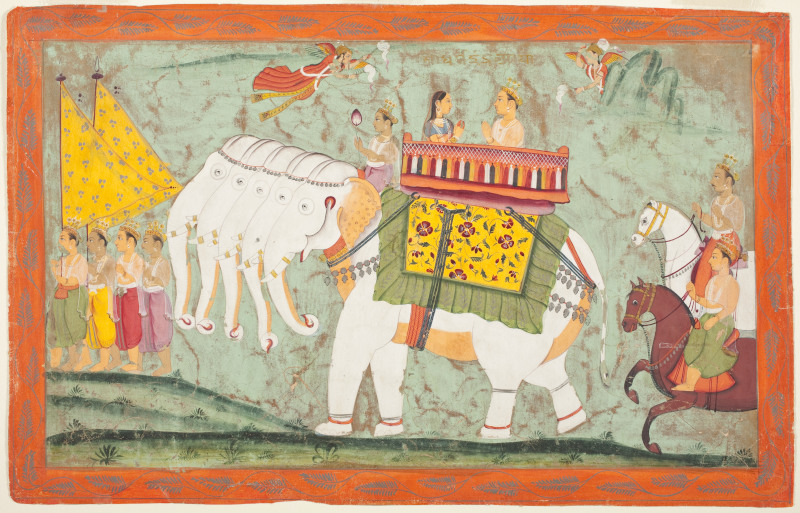 Indra and Sachi Riding the Divine Elephant Airavata (image courtesy of rawpixel)
Indra and Sachi Riding the Divine Elephant Airavata (image courtesy of rawpixel)
Tips and Techniques to Drawing Elephants for Beginners
There are many tips and techniques for quick and easy drawings of elephants that can easily be applied to most other animals and living creatures. Firstly, observation is key, and even the great masters with genius-level abilities were required to observe elements for long periods in order to truly understand their finer points. Secondly, practice is also key as no-one will achieve exactly what they desire straight away. Tracing existing images is a great way to master the basics, working on simple outlines before progressing into more detail.
It is best to start to this simple outline before moving on to basic shapes with which you can build up the elephant anatomy. Circles, squares and rectangles should be enough to form the key parts of the elephant, though you will need to focus on proportion in order to get each element sized correctly in relation to the rest of the body. This is where observation is critical. And then, finally, once you are happy with this loose sketch, you can start to add in greater detail and move towards a completed sketch.
From Realism to Abstraction: Stylistic Approaches
Realism artists have tended to focus on accuracy, but also specifically the textures of this stunning creature, which offers a unique challenge to artists already familiar with animal art. The surface skin of elephants is almost stone-like to touch, and this has allowed some interesting opportunities for curious artists. Impressionist artists tend to use elephants in movement, capturing a specific moment in time. This is well suited to their loose brushwork, which replicates what we see with our eyes when objects move across our line of vision.
Surrealism artists would incorporate elephants with elongated limbs, as found in the work of Salvador Dali, whilst abstract artists have created elephants from very simple arrangements of lines and shapes, though their clever skills have allowed us to identify the animal within the scenes. In truth, ever since elephants were more broadly understood across western society, so their images has appeared across the full gamit of western art.
Masters of Line and Form: Artists Portraying Elephants
Most artists to have covered elephants successfully did not specialise in this animal alone, but rather spent considerable time studying and observing a variety of animals, birds, fish and insects across their lifetime, then choosing to cover elephants at some point within that. The number of famous names who covered this creature was limited by the lack of accessbility that most western artists had to elephants, with many relying on other people's sketches, leaving to many errors in the earliest years. Some would also re-use their techniques from other animals, and just adapt to the elephant's most obvious differences, leading to some bizarre images and strange combinations.
The arrival of zoos and wildlife parks, as well as greater global travel has helped to change this considerably, and the later influx of film and television also helped to dramatically improve our understanding of these creatures. The artists with the greatest interest in anatomical accuracy can also now study elephant skeletons within the west, and a large number of publications have been made around the proportions of its body, as well as historical illustrations being re-published.
Elephant Art in Festivals and Ceremonies
Elephants are often featured in festivals around the world, most commonly in India, Thailand, Sri Lanka, and parts of Africa. These festivals tend to celebrate individuals of great importance from the past, or historical events and the elephants would be decorated in a variety of ways for these processions. They may be dressed in flowers, or have hennas drawn on their bodies in order to prepare each festival.
Elephants have also had connections to various gods, particularly in Indian culture, and so the use of elephants to celebrate different figures is completely understandable. They also hold different symbolic values in different cultures, and so for some these choices might seem unusual, but are completely normal to others. Others more recently have used elephants to build a connection with humans, to encourage greater efforts in terms of their long term conservation.
The Global Appeal of Elephant Art
Elephants remain a much loved animal which is famous all across the world. It is respected for its unusual anatomy, as well as the incredible size and weight of its adults. It is seen by most as an exotic animal, because of the few regions in which it roams in the wild, and some are also aware of elephants through the bi-products which have been sold globally and taken directly from the animal itself. Today, we come together as a global community to try to protect these creatures and elephant art has played a role within that.
Many depictions of these animals with need little introduction to the audience, and can easily translate across different cultures. Some regions are particularly protective of their elephants, where perhaps the animal holds a religious meaning, but even in those that it doesn't, many will stil strive to avoid reducing its numbers any lower than has already happened over the past few centuries.
Wildlife Conservation Through Pencils and Brushes
Art can give a certain level of power, or at least strength, to artists who want to give their opinions on certain topics. Rather than simply producing a single artwork, they can create posters and distribute them widely, helping as many as possible to understand their point of view. With the spread of the modern media and social media, it is possible to gain attention from anywhere in the world, often for relatively nominal amounts of money. The internet has brought many advantages in terms of making the world more equal, in terms of spreading opinions, but there have also been some disadvantages too.
That said, the use of pencils and brushes does not instantly lead to conservation improvements, for example. The artist will have to work hard to perfect the impact of their work, and also to find the right audience. Often this is achieved by partnering with established charities who will already have access to a suitable audience.
The Role of Elephant Drawings in Education
Education relies on highly accurate art which can illustrate the attributes of different creatures. The 18th and 19th century marked a major point in the understanding of many animals, as travellers reported their findings and many new publications were released. Artists would work alongside experts to produce illustrations alongside detailed texts, bringing to life these sometimes exotic creatures. Elephants were similar in this regard, and it took time before you could describe elephant art as accurate, or useful in an educational setting.
These scientific studies won't always be to everyone's taste from an artistic point of view, and lack the variety of other styles, but the qualities that they possess lie in the accuracy and devotion to replication of each species. That said, some would be pencil drawings that were then adorned with watercolor, creating beautiful works in some cases that could easily be presented as art prints for your own home.
The Digital Canvas: Elephant Drawings in the Digital Age
Online fundraising has brought massive opportunities to conservation charities with digital art being used to help promote various causes. It requires far fewer resources to promote a campaign online, shared through social media, than it would be to produce poster art and paste its image all across a city. There is also a much more targeted manner to modern advertising, helping companies to achieve better results. Elephant drawings can be constructed digitally, and then shared in minutes.
Artists may use digital pens to sketch in a similar manner to the more traditional approach, but then take advantage of software to tweak their work as they go. They can then be manipulated afterwards, such as changing the entire palette in just a few seconds, as well as being re-purposed for merchandise and all manner of different types of advertising.
Contemporary Elephant Artists, including Sculptures, Paintings and Drawings
Art has become more interactive and accessible in many ways since around the 1950s. Museums and galleries have attempted to make their exhibitions as attractive as possible to a wide audience, and so the days of simply arranging a few artworks on the wall is long gone in many cases. Typically, there will be an attempt to display different styles of art on the same subject, in order to deliver a fresh and interesting experience. Some will be interactive, with sculptures and temporary displays being used to provide a more rounded experience that can also include sound.
There are few artists who have specialised in elephants, and most of those who have achieved success within this genre have also taken on a number of other animals too. Followers will tend to have an interest in wild animals more generally, and so enjoy this variety, though each species certainly brings its own challenges, ensuring that regular observation and study is necessary to master each and every species.
Drawing Anatomy and Behavior: The Natural World of Elephants
Many victorian images of elephants would place them in somewhat stale, artificial postures in which we could learn much about their anatomies, but little else. Efforts have since been made to sketch elephants within their natural habitats, so that we can better understand their daily lives, which we cannot glean from visiting these animals within zoos. Whilst safari parks are more closer to reality, there is much still we will miss out on and so artists have attempted to capture the full beauty of these wild environments, sometimes incorporating multiple elephants together, or alongside other wild animals.
Artists will rarely sit in the wild, sketching these highly dangerous creatures! As such, they may study photography, which can be taken from a further distance and also combine this with studies in zoos to get an overall picture which is accurate enough for their art. Many of those looking to purchase art will also prefer the natural element of the habitat, where perhaps these valuable bonds between animals can be celebrated, and for some it might remind them of their own holiday within a similar environment.



